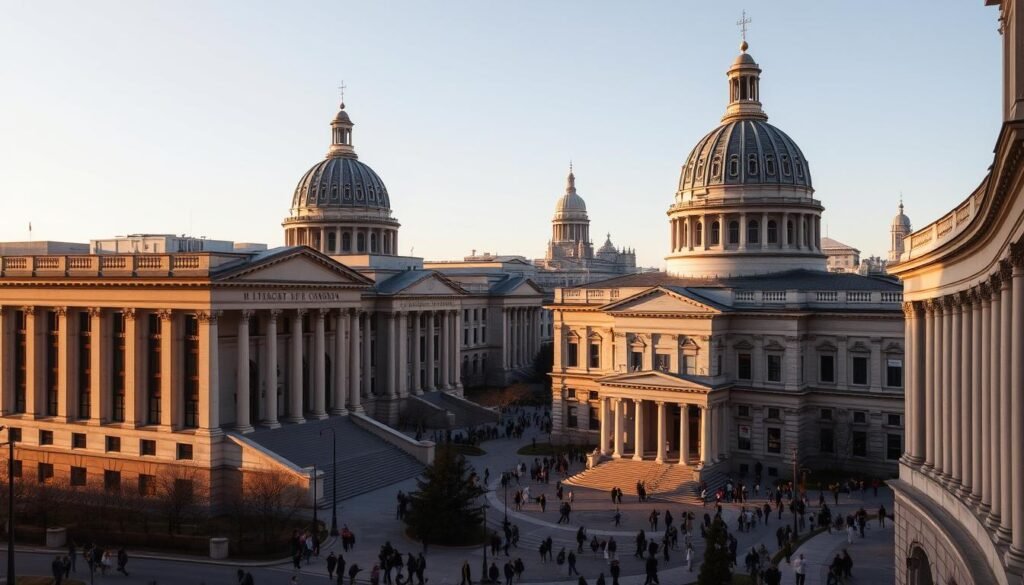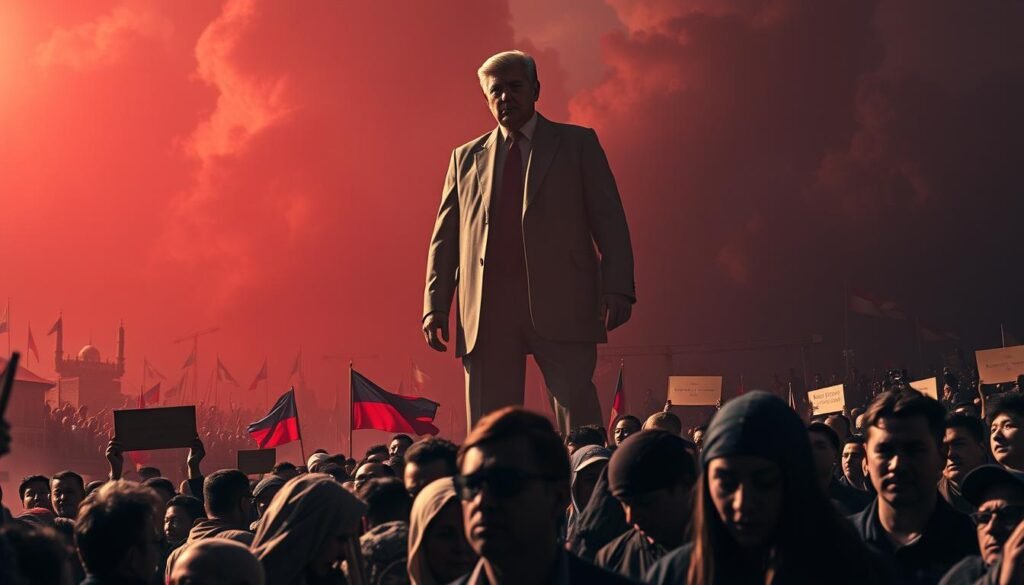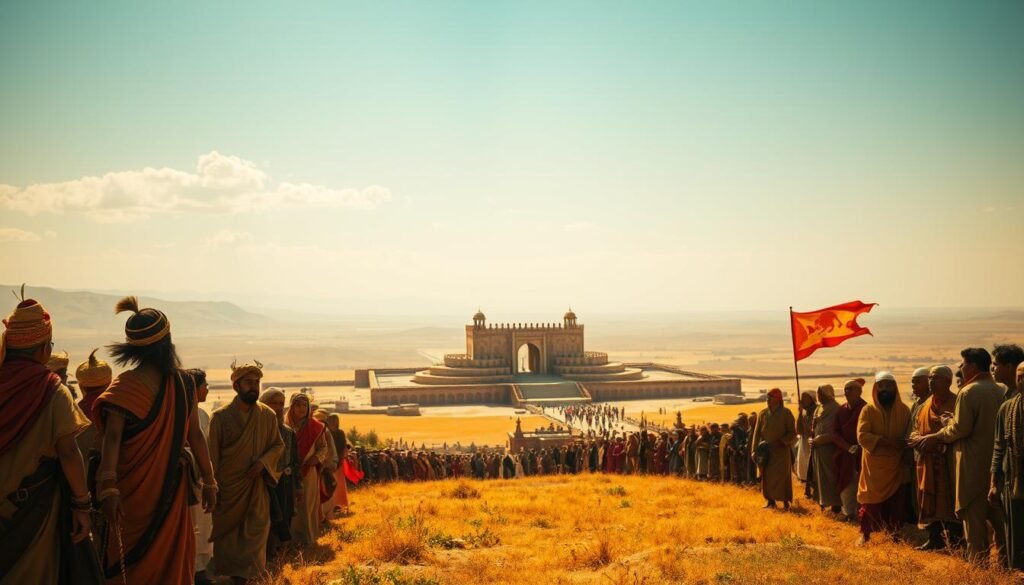Democracy Challenged: Understanding the Growth of Authoritarianism – Democracy and the Rise of Authoritarianism
Over 50 percent of nations are democracies, but nearly one-third are semi-authoritarian regimes. These systems mix democratic looks with real authoritarian control. This mix threatens the core of liberal democracy, causing big political risks.
It’s urgent to rethink how we balance sovereignty and freedom. The rise of semi-authoritarianism is a big worry. It shows a shift away from traditional politics.
In these regimes, elections and freedoms look real but power is held by a few. This raises big questions about political integrity and democratization efforts. The stability of these regimes is fragile, threatening global democracy.
The rise of semi-authoritarian systems is a big challenge to liberal democracy. These regimes claim to be democratic but control power in a tyrannical way. This forces us to question the strength of democracy against such threats.
Key Takeaways
- The increase in semi-authoritarian regimes is a big worry for global democracy.
- These systems pose big political risks by hiding authoritarian control behind democratic looks.
- Understanding semi-authoritarian regimes is key to knowing if political reforms are real.
- The rise of authoritarianism challenges liberal democracy and shows democracy’s weakness.
- It’s important to re-evaluate and be aware of these trends to face global political challenges.
The Fragile Balance Between Freedom and Control
The mix of civil liberties and governmental power shapes political environments, mainly in authoritarian regimes. These systems offer some freedoms but control them tightly. This balance is key for the regime’s stability and its image at home and abroad.
In semi-authoritarian regimes, there’s a fine line. They allow some civil society and press freedom but limit real political competition. This careful balance helps these regimes keep control while avoiding the risks of full democracy.
This mix of freedom and control doesn’t show a democracy in the making. Instead, it’s a system with some freedom but mostly authoritarian rule. This balance is tricky but helps the regime stay in power without causing big problems.
Understanding this balance helps us see how these political systems work. It shows the ongoing fight between public freedom and government control. Knowing this is important for figuring out the true state of freedom in semi-authoritarian places.
Democracy and the Rise of Authoritarianism: A Contemporary Overview
In recent years, the world has seen a big shift towards authoritarian populism. This shift has challenged the core of democratic institutions everywhere. Charismatic leaders use political ideas that tap into people’s fears and frustrations.
Growing Influence of Authoritarian Leaders
Authoritarian leaders have become more common. They reject traditional democratic values, pushing for strong, decisive rule. They use social media to show themselves as direct and quick, unlike the slow pace of democracy.
Impact on Public Institutions
Authoritarian populism weakens democratic institutions. Over time, these institutions, like courts and legislatures, face challenges that erode them. Leaders claim they are acting on the people’s will, making any opposition seem anti-democratic.
The Role of Technology in Shaping Narratives
Technology, like social media, is key in spreading authoritarian leaders’ ideas. It lets them reach many people quickly. Social media can help democracy or spread false information, depending on how it’s used.
| Feature | Democratic Institutions | Authoritarian Populism |
|---|---|---|
| Leadership Style | Collective, consultative | Centralized, charismatic |
| Political Ideologies | Inclusive, pluralistic | Exclusive, divisive |
| Role of Social Media | Platform for debate | Tool for propaganda |
| Impact on Public Trust | Builds through transparency | Exploits via division |
The rise of authoritarian populism is a big challenge today. It tests the strength and flexibility of democracy. As this situation evolves, democracy’s core values need strong defense and a renewed commitment to follow the constitution.
Evaluating Historical Shifts in Political Systems
The 20th century saw big historical shifts and political transformations. These led to the ideological triumph of constitutional democracy. But, today, we see a mix of democratic and semi-authoritarian elements in politics. This mix makes us wonder about the system characteristics of political systems and how they adapt to new needs and pressures.
Some regimes keep democratic ideas but add semi-authoritarian traits. This creates a system that looks democratic but really has a strong leader. The goal is to keep control and avoid criticism from the world.
Today’s politics are a mix of different models. These systems are not fully democratic or fully authoritarian. They show us how politics are changing and what the future might hold. Below, we compare these hybrid systems, looking at their key features and how they work.
| Features | Democratic Systems | Semi-Authoritarian Systems |
|---|---|---|
| Election Process | Free and Fair | Controlled or Manipulated |
| Role of Media | Independent | State-controlled or Heavily Regulated |
| Judicial Independence | High | Compromised |
| Civil Liberties | Protected | Restricted |
It’s important to understand these changes. People like policymakers, scholars, and international groups need to know. They have to deal with the big ideas and practical effects of these changes. These changes affect global peace, security, and human rights.
Global Politics and Their Influence on Modern Governance

The world of modern governance is greatly influenced by global politics. This includes superpower influence and their complex alliances. These elements shape diplomatic relations and global policy-making. It’s important to grasp how these factors are connected.
In the ever-changing world of global politics, economic challenges play a big role. They affect a country’s stability and direction. The decisions made about these challenges are key, balancing financial stability with democratic values.
The media’s political influence is also significant. It shapes public opinion, reflecting or molding it. Media coverage greatly impacts how policies and leaders are seen, potentially changing governance.
| Superpower | Political Influence | Economic Impact | Media Role |
|---|---|---|---|
| USA | Alliances with multiple countries | Global trade leadership | Narrative shaping through major networks |
| China | Expansion in South China Sea | Major global investor | State-controlled media influence |
| Russia | Military presence in Eastern Europe | Energy supply control to Europe | Use of media for state propaganda |
Each superpower uses its strengths in a complex global scene. Here, superpower influence, economic challenges, and media’s political influence are key. They shape not just national but also global politics. Understanding this interplay is vital for grasping modern governance in international relations and internal pressures.
Social Trends Reinforcing Authoritarian Dynamics
In today’s politics, some trends make authoritarianism worse. These trends tap into deep fears and identities. They push public talk and laws towards more control and less participation.
Fear-based politics play on emotions. They help authoritarian leaders rise by promising safety in hard times.
Fear-Based Campaigning
Leaders use fear to grab power. They make big deals out of threats to safety or security. This makes people see the government as the only one who can protect them, distracting from real problems like money issues or fairness.
Nationalism and Cultural Identity
Nationalism and cultural identity are big in today’s world. They help authoritarian leaders by making people see things in simple ‘us versus them’ terms. This makes complex global problems seem like national fights.
- Patriotic symbols are powerful tools to show loyalty to the state.
- Cultural identity creates a line between ‘true nationals’ and ‘others.’ This often ignores minority groups and different views.
These trends together help authoritarian leaders push through policies that might face a lot of opposition. The link between social trends and authoritarian rule shows we need to watch out and act to keep democracy alive.
The United States Perspective

In the United States, mixing democracy in America with semi-authoritarian trends is a big challenge. It affects both home and world politics. The way people vote is key to keeping democracy strong.
This mix of values and politics needs careful thought in making laws and getting people involved. It’s a delicate balance.
The US government is built to keep power in check. But today, it faces challenges from deep political divides. This system is vital for democracy in America, preventing one group from having too much power.
But, changes in voting and the rise of big lobbying groups are making things tricky. They push for a look at how to get more people involved and make better laws.
| Political Ideology | Influence on Policy | Impact on Voter Engagement |
|---|---|---|
| Conservative | Strong focus on national security and economic liberalism | Highly mobilized in specific regions, influencing local and national elections |
| Liberal | Emphasis on social justice and environmental regulations | Active in grassroots movements and young voter turnout |
| Centrist | Mediates between extreme ends, often influencing bipartisan policies | Variable, often swings based on the issues at stake in electoral cycles |
The table shows how political ideologies in the US shape laws and affect voting. It’s important for leaders to grasp these connections. This way, they can lead the country well and keep democracy alive and open to all.
Examining Government Structures and Their Vulnerabilities
Modern governments aim to keep power in check and protect democracy. But, they have weaknesses that can be used by those who want more control. These weaknesses often come from a breakdown in checks and balances, key to a healthy democracy.
The strength of constitutional protections depends on those in power’s commitment to them.
Constitutional safeguards are the heart of democratic societies. They protect individual rights and keep government actions lawful and ethical. But, if these safeguards are weakened, democracy starts to fall apart. This allows those in power to control more.
Checks and Balances at Risk
Checks and balances are key in modern governments. They stop any one branch from getting too much power. This balance is vital for accountability and democracy. Yet, some leaders try to bypass or weaken these checks, leading to a concentration of power.
Constitutional Safeguards
Constitutional safeguards protect civil liberties and ensure fairness. They limit government power and protect the rights of all. When these safeguards are ignored, abuse of power becomes easier. This weakens the effectiveness of constitutional protections.
Connecting Power Dynamics to Policy Outcomes

In semi-authoritarian systems, it’s key to understand how power dynamics and policy outcomes interact. These systems seem to offer diversity and choice but really control everything. This mix of seeming freedom and strict rule shapes the policies made.
The political control at the center affects how well policies work and where they go. This control limits real democratic changes. It makes sure reforms look real but don’t really change things, guiding policies to fit a certain plan.
| Aspect of Control | Impact on Policy Outcome |
|---|---|
| Centralized Decision Making | Limited Policy Diversification |
| Manipulation of Electoral Processes | Predetermined Policy Trajectories |
| Control Over Media Narratives | Shaped Public Perception and Compliance |
Being able to shape policy outcomes through power dynamics shows why we must carefully look at governance strategies. Knowing these patterns helps those who want better, more open governance.
Public Engagement and the Threat of Apathy
In today’s world, public engagement is key to keeping democracies alive. But, voter apathy is growing, hurting democratic participation and civic action.
Looking at voter turnout trends, we see a worrying drop in some areas. This decline questions the strength of democratic systems and the role of social media in public engagement.
Voter Turnout Trends
Recent elections show a mixed picture of voter turnout. There’s a big gap in engagement among different groups. Despite efforts, some age groups and communities are not voting.
Social Media Activism vs. Real-World Action
Social media has changed how we engage in politics. Sites like Facebook and Twitter are full of political talk and action plans. But, turning online buzz into real change is hard. This often leads to empty promises of engagement without real policy shifts.
This mix of digital activity and low voter turnout makes us question the effectiveness of today’s activism and public involvement in politics.
Cultural Narratives and Their Role in Shaping Ideologies

The role of cultural narratives in shaping political ideologies is huge. They mix history, media, and education to create big stories that shape our views. This process, called ideological shaping, turns cultural values into a clear view of the world. This view affects how we govern and get involved in politics.
Societal stories greatly influence political views, which guide government actions. It’s key to see how these stories affect us. They can make or break leaders, policies, and even cultures. This process shows the deep connection between a culture’s history and its politics.
- The inclusion of cultural values in school curricula shapes young minds politically.
- Leaders or big groups create stories to push a certain political view.
- Politicians use stories to change public opinion or keep their power.
This mix of history, memory, and shaping shows the big impact of cultural stories in politics. They show us what’s happening now and shape our future by changing our views.
The Interplay Between Political Ideologies and Leadership Styles
The connection between political ideologies and leadership styles is key in forming governments and policies. Each ideology, like conservative approaches, progressive politics, and centrism, has its own vision for how to lead. These visions shape our society and how we interact with the world.
Conservative approaches value tradition and slow change. On the other hand, progressive politics push for quick changes to make society fairer. These two often disagree on how to move forward.
Centrism tries to find a middle ground between these extremes. But, it can struggle with big issues or when leaders use division to gain power. These leaders might only listen to parts of the political spectrum that agree with them.
- Conservative strategies focus on keeping the economy stable and enforcing laws, appealing to those who want safety.
- Progressive strategies aim to improve access to healthcare and education, appealing to those who want fairness.
- Centrism tries to find a middle path, but might not work in extreme situations.
The way these ideologies and leadership styles work together is clear in policy-making. Each style leads to different priorities and results. Knowing this helps us predict future trends and prepare for their effects on our country and the world.
| Political Ideology | Focus of Leadership | Common Strategies |
|---|---|---|
| Conservative | Tradition and Stability | Incremental changes, strong defense policies |
| Progressive | Reform and Equality | Social reforms, environmental policies |
| Centrist | Balanced Approach | Moderation in policy, compromise between extremes |
In conclusion, the mix of political ideologies and leadership styles is vital in shaping policies and international relations. It’s important for everyone to understand this to see how governance will evolve and affect the world.
Challenges to Civic Liberties in Evolving Democracies
In the world of democratic evolution, there’s a big challenge. It’s about keeping civil liberties safe while some policies try to take over. This mix of human rights challenges shows how hard it is to balance freedom and control in new democracies.
Some governments use laws to seem strong but actually limit our rights. These laws might look good but really hurt our freedom. They can make it harder for democracy to grow.
To fight these issues, we need a watchful public and groups that protect human rights. We must keep an eye on laws and make sure they don’t harm our freedoms. This helps keep democracy strong and free.
Understanding the limits on civil liberties in evolving democracies is key. It helps make sure freedom doesn’t slip away to more control.
It’s important for local activists and global watchers to stay active. Democracy’s strength comes from people being able to speak out and challenge without fear. This is what keeps a democracy alive and healthy.
Comparing Authoritarian Strongholds Across the Globe
The world of authoritarian regimes is diverse, with big changes in Asia and Eastern Europe. These areas show the tough work and changes in regional governance. They give us a close look at how political reform aims to move towards more democracy.
In Asia, the use of authoritarian methods is growing. Governments are taking more control over society and politics. This shift raises big questions about the future of freedom and stability in the region.
Asia’s Rising Authoritarian Specters
Asia is seeing more authoritarian actions, with states controlling more and giving people less freedom. Many countries are making their political systems stricter. This makes it harder for opposition and change to happen. It also worries about human rights and how the region will interact with others.
Eastern Europe’s Shift in Governance
Eastern Europe is also moving away from democracy, with some gains being lost. The move to authoritarianism is seen as a way to protect national interests and keep the state strong. This is against outside and inside pressures.
Regional Case Studies for Reform
But, there are efforts towards political reform in these places. These efforts show that change is possible but hard. Studies from different countries show attempts to change policies, involve civil society, and bring back checks and balances, even in tough systems.
It’s key to understand these changes for those living under these regimes and for the world. By looking at these areas, we can learn about the strength of democracy and the big challenge of authoritarian growth.
Strategies for Securing Democratic Principles
With authoritarian trends on the rise, it’s vital to find ways to protect democratic principles. We need to focus on reform strategies and political resilience. These should fit the needs of different places going through democratic transitions.
Building democratic resilience means more than just fighting against threats. It’s about making institutions stronger and more democratic. This strategy tackles both short-term dangers and long-term weaknesses in political systems.
| Strategy Element | Focus Area | Expected Outcome |
|---|---|---|
| Civic Education | Public Awareness and Participation | Enhanced understanding of democratic rights and responsibilities |
| Legal Reforms | Legislative Strengthening | Robust laws that safeguard free speech and right to information |
| Decentralization of Power | Local Governance | Increased political engagement at the local level |
| Technological Transparency | Government Processes | Greater accountability and reduced corruption |
To make democratic transitions last, we need specific reform strategies. These should remove authoritarian leftovers and build a strong democracy. Such efforts are key to creating a place where democracy is not just a temporary thing but a lasting part of society.
Advocating for Change: A Citizen’s Role in Preservation
In today’s world, advocacy for change is key to keeping democracy alive and fighting against authoritarianism. This effort is seen through many ways. Grassroots movements, media support, and pushing for accountability in leadership are all important.
- Grassroots Movements and Community Organizing – These movements are the heart of citizen participation. They let people at the local level make real changes. They are a key force in getting communities to act and change society.
- Supporting Media Freedom – Free media are vital for an informed public. Supporting media freedom is a key part of democracy. It ensures we know what’s going on and keeps leaders honest.
- Holding Leaders Accountable – Leaders must be accountable for democracy to work. It’s important they keep their promises and act fairly. This way, power is used right and openly.
These parts all help with advocacy for change. They also help protect democratic values from being lost.
Conclusion
The shadow of authoritarian challenges affects global governance deeply. Democracy faces a test as authoritarian regimes offer order but take away freedom. We must focus on keeping democracy alive, which means always being watchful and supporting free societies.
The future of governance depends on active political engagement. Citizens must use their rights to shape policies and keep leaders in check. History, current trends, and global leadership show that protecting civic liberties is key to strong democracies.
Protecting democracy requires more than just watching; it needs action. We need grassroots movements, open communication, and a commitment to transparent policies. As we navigate the 21st century, our work to support democracy will shape its future worldwide.




